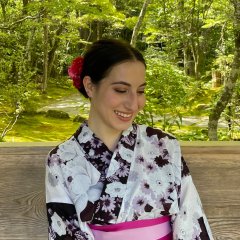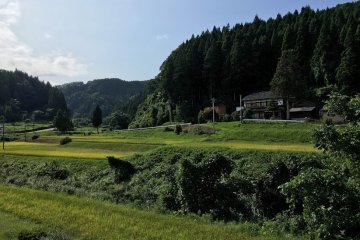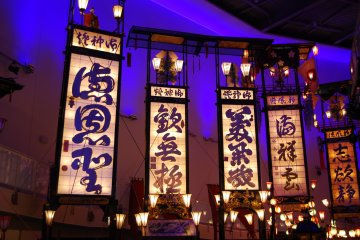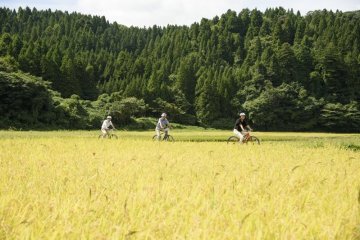Ishikawa Prefecture, located on Japan’s western coast, has long been renowned for its cultural heritage and thriving art scene, both of which found their roots in its capital, Kanazawa, over 400 years ago.
The story began in 1583 when the powerful Maeda clan took over Kanazawa Castle. This clan’s wealth and power were comparable to that of the Tokugawa Shogunate, Japan’s military government during the Edo Period (1603–1868). To show that they were not a political threat to the Shogun (military ruler), the Maeda clan dedicated themselves to Japanese culture, arts, and academics. This dedication combined with Japan’s widespread peace during the Edo Period, allowed Kanazawa to blossom into a refined city filled with cultural arts.
Even after the Maeda clan lost their political power, Ishikawa’s residents and artisans continued to carry on the prefecture’s legacy for future generations. Experience Ishikawa’s prestigious history and unyielding spirit for yourself.
Sightseeing spots and experiences
Kenrokuen Garden

Kenrokuen is regarded as one of Japan’s three most beautiful landscape gardens and is designated as a Special Place of Scenic Beauty. Kenrokuen’s name literally translates to “combined-six-garden,” which is a reference to a classical Chinese book. The book notates six contradictory gardening techniques that are said to create the perfect garden, and Kenrokuen masterfully balances them all. The garden is spacious without sacrificing seclusion. It harmonizes human design with authentic representations of nature and features water elements, while still offering commanding panoramas.
Together, the garden’s cherry, pine, plum, and maple trees, water features, winding pathways, plantlife, and stone lanterns create a tranquil atmosphere that borders on mystical. The gentle sounds of rustling leaves and running water follow every breeze—blessing the garden with a peaceful soundtrack. For a representative view of Kenrokuen, be sure to snap a photo of Kotoji Lantern with Kasumigaike Pond in the background. The garden also has small tea houses and eateries where you can relax with light meals and beverages. Kenrokuen’s beauty changes with the seasons, so repeat visits are a must.
Access: Kenrokuen is about a 20-minute bus ride from Kanazawa Station.
Google Map: Kenrokuen Garden
Kanazawa Castle Park

Kanazawa Castle, which is directly next to Kenrokuen, served as the Maeda family’s residence from 1583 to 1869. Afterwards, the castle was used as an army base and then a university campus, before opening as Kanazawa Castle Park in the mid-1990s.
Unfortunately, Kanazawa Castle burned down numerous times over its history and today, is only home to a few original structures, including Ishikawamon Gate—one of the castle’s most popular entrances. Since the mid-1990s, a restoration project has been underway to restore the castle using original construction techniques. In the center of the park, you can enter three beautifully restored structures: Hishiyagura Turret, Gojukken Nagaya Warehouse, and Hashizumemon Tsuzuki Turret. Inside, these structures display information about the architectural techniques used during the restoration process. Other points of interest are Kanazawa Castle’s stone walls, which feature natural, rough stone, and cut stone stacking techniques.
The castle’s elegant, yet commanding presence makes for a captivating visit.
Access: Kanazawa Castle Park is a short walk from Kenrokuen and about a 20-minute bus ride from Kanazawa Station.
Google Map: Kanazawa Castle Park
21st Century Museum of Contemporary Art, Kanazawa

Nestled beside Kenrokuen and Kanazawa Castle, the 21st Century Museum of Contemporary Art, Kanazawa is an esteemed museum that exhibits contemporary artworks by both Japanese and international artists. Architecturally, the museum embodies contemporary design with its sleek, circular construction, white color palette, and floor-to-ceiling windows. The facility’s perimeter is dotted with a variety of sculptures that play with colors, materials, and forms, and guests are encouraged to interact with the artworks.

Inside, the museum houses a number of temporary exhibits and permanent installations. One of its most renowned permanent works is The Swimming Pool by Leandro Erlich. This life-sized pool creates an interactive illusion of guests standing below water. Visitors can also enter the pool themselves and experience the water-distorted faces of other guests peering at them from above.


In addition to its thought-provoking works, the museum also has a stylish restaurant, museum shop, teahouse, art library, and children’s play area.

Access: The museum is about a three-minute walk from Kenrokuen’s Mayumizaka exit and a 10-minute walk from Kanazawa Castle Park’s Ishikawamon Gate. From Kanazawa Station, the museum is a roughly 20-minute bus ride.
Google Map: 21st Century Museum of Contemporary Art, Kanazawa
Gold leaf experience at HAKUKOKAN, HAKUICHI’s main store

Gold leaf is one of Ishikawa’s most famous traditional crafts, and Kanazawa itself produces roughly 100% of Japan’s gold leaf. In the past, gold leaf was primarily used to decorate temples and shrines, as well as crafts for cultural arts like Noh theater and tea ceremony. Presently, the craft has expanded to also include food, cosmetics, and more.
HAKUICHI, founded in 1975, is a metal leaf manufacturer dedicated to preserving and sharing the beauty of “Kanazawa Gold-leafed Craft.” At HAKUICHI’s main store, HAKUKOKAN, you can see, touch, and experience gold leaf up close with its shop, cafe, museum, and hands-on workshop.
The roughly 30-minute workshop allows you to customize a box, a plate, a mirror, a platter, or chopsticks with a gold leaf design of your choosing. You can opt for a premade sticker or fabricate your own design with tape. The workshop is easy to follow and fun for people of all ages! After the cultural experience, you can check out the museum, peruse the shop full of refined wares, and treat yourself to some gold leaf ice cream.

Access: Taxi travel is the best way to reach HAKUKOKAN. From Kanazawa Station, a taxi ride is about 10-15 minutes. HAKUKOKAN even offers 1,000 yen cash-back for customers who travel via taxi (taxi receipt required) and spend at least 5,000 yen at the facility. Alternatively, you can take a bus from Kanazawa Station to Konocho Bus Stop and then walk to the facility. Together, the bus travel and walking time are about 45 minutes.
Google Map: HAKUKOKAN, HAKUICHI’s main store
Kaga-Yuzen Kimono Center

Kaga-Yuzen is an ornate dyeing method that originated during the 17th century in the Kaga district—southern Ishikawa. This technique is characterized by its bold colors and intricate designs of nature and is typically applied to kimono. The refined dyeing method requires patience, care, time, and skill, making it a highly valued traditional craft.
Kaga-Yuzen Kimono Center is a facility that aims to promote the beauty and artisanal process of Kaga-Yuzen. The center has a special exhibition room that displays Kaga-Yuzen kimono and information about the dyeing process, as well as a shop, free rest area, and workshop area.
The Kaga-Yuzen dyeing experience is arguably the center’s most immersive offering—allowing you to hand-dye a handkerchief or stencil dye a handkerchief, tote bag, or drawstring bag. The classes take about 20 to 60 minutes and are appropriate for children and adults. The insightful experience helps you better appreciate the level of skill required for Kaga Yuzen and leaves you with a one-of-a-kind souvenir.
Access: Kaga-Yuzen Kimono Center is about a five-minute walk from Kenrokuen’s Sakuragaoka exit and a seven-minute walk from Kanazawa Castle Park’s Ishikawamon Gate. From Kanazawa Station, the center is about a 15- to 20-minute bus ride.
Google Map: Kaga-Yuzen Kimono Center
Restaurants and cafes
TILE

TILE is an atmospheric restaurant that serves rice bowls in an artistic manner. The restaurant’s main dish, aptly named the Kanazawa Mosaic Bowl, features your choice of white or red vinegared rice with five, six, or eight toppings. There are 30 different kinds of toppings available, including raw fish like tuna, salmon, horse mackerel, and yellowtail, as well as roast beef and duck confit. Your desired toppings are then elegantly plated side by side in small glass cubes, creating the titular mosaic pattern. The meal is served with Japanese pickles and additional garnishes, like soy sauce, a sesame-based sauce, lime, wasabi, horseradish, and plum jelly. TILE also offers a vegan option, has English menus, and has English-speaking staff so everyone can enjoy the dining experience.
The restaurant is located in a beautifully renovated 110-year old townhouse and has a nijiri-guchi, which is a small entrance usually reserved for tea houses. The entrance makes the restaurant feel more exclusive, and its modern interior design adds to the refined dining experience.
For more exceptionally fresh seafood, you can also visit nearby Omicho Market, which is Kanazawa’s largest fresh food market since the Edo Period. The market is home to roughly 200 shops and is a popular place for tourists and locals alike to enjoy rice bowls filled with Kanazawa seafood.
Access: TILE is about a four-minute walk from Kanazawa Station.
Google Map: TILE
WAGURI SHIRATSUYU

WAGURI SHIRATSUYU is a luxurious cafe that specializes in Japanese chestnut desserts. Located near the historic Higashi Chaya District, WAGURI SHIRATSUYU draws visitors in with its traditional facade and has an interior that blends modernity with the past.
Among its high-quality chestnut desserts, the cafe’s most famous offering is its Mont Blanc which features layers of sponge cake, fresh cream, and chestnut cream topped with strands of piped chestnut puree. The cafe’s signature “Harizuri” Mont Blanc is made with aged and roasted Noto chestnuts that are known for their deep aroma and natural sweetness. Aside from its dine-in desserts, you can also purchase chestnut sweets for takeaway, such as canelés.
Access: WAGURI SHIRATSUYU is in Kanazawa’s Higashi Chaya District and is about a 16- to 20-minute bus ride from Kanazawa Station.
Google Map: WAGURI SHIRATSUYU
Cafe MURAKAMI

Founded in 1911, MURAKAMI is a confectionery that specializes in traditional Japanese sweets. The confectionery has numerous stores throughout Kanazawa, including Kanazawa Station, Nagamachi (Samurai District), and the Higashi Chaya District.
Most of MURAKAMI’s branches have delicious dine-in and takeout options! Some of the cafe’s packaged traditional sweets include manju (a small bun) filled with sweet red or white bean paste, dried fruit yokan (sweet bean paste, sugar, and agar), and wari ice (agar, sugar, and water from Mt. Hakusan).
MURAKAMI also serves a variety of delicious dine-in eats, including dango (ball-shaped dumplings made from rice), fruit parfaits, drinks with warabi mochi (rice cake made from bracken root), fluffy pancakes, dorayaki (two pancake-like patties with a filling), and Mont Blanc. MURAKAMI’s cafes are the perfect places for you to enjoy traditional Japanese and modern fusion sweets.
Access: The MURAKAMI Cross Gate Kanazawa Store is about a six-minute walk from Kanazawa Station.
Google Map: MURAKAMI Cross Gate Kanazawa Store
Accommodations
Yamashiro Onsen, Katayamazu Onsen, and Yamanaka Onsen
Kaga Onsen in Ishikawa Prefecture is a captivating retreat where tradition and stunning natural beauty come together. In Yamashiro Onsen, visitors can stroll through the charming streets of "Yuno-gawa" centered around the historic Kosoyu bathhouse, offering a rich bathing experience steeped in history. Yamanaka Onsen boasts 1,300 years of history and breathtaking views of the Kakusenkei Gorges, along with the allure of traditional crafts. At Katayamazu Onsen, you can soak in hot springs while enjoying the seasonal beauty of Lake Shibayama and the magnificent views of the Hakusan Mountain Range.
Photo source: © Ishikawa Prefectural Tourism League
Access: From Kanazawa Station, Kaga Onsen Station is about a 50-minute train ride on the IR Ishikawa Railway Line. From Kaga Onsen Station, you can take local buses to the different onsen towns. Travel times range from 30 to 60 minutes.
Google Map: Kaga Onsen Station
Visit Ishikawa Prefecture
Ishikawa’s blend of prestigious cultural heritage, artistic wonders, preserved history, delectable eats, and healing hot springs, make it a unique destination where both your mind and body will feel enriched. Also, thanks to its easy access from Tokyo and nearby prefectures, Ishikawa is a highly accessible area! Discover this vibrant side of Japan.

Access to Ishikawa
Ishikawa is easily accessible by plane, train, and bus.
Plane
Ishikawa is home to two airports—Komatsu Airport in southern Ishikawa and Noto Satoyama Airport in northern Ishikawa. Flights between Tokyo’s Haneda Airport and Komatsu Airport generally take a little over one hour. From the airport, you can take the Komatsu Airport Limousine Bus, which departs 15 minutes after the arrival of each flight, to Kanazawa Station. The bus ride is about 40 minutes. The Komatsu Airport Limousine Bus also stops at Komatsu Station (about a 15-minute bus ride), where you can transfer to the IR Ishikawa Railway Line for other destinations like Kaga Onsen.
Train
From Tokyo Station, Kanazawa Station is about a 2.5-hour train ride via the Hokuriku Shinkansen. From Osaka, Kyoto, and Nagoya Station, you can catch an express train to Tsuruga Station in Fukui Prefecture. The train ride is between one hour and one hour and 40 minutes. From Tsuruga Station, you must transfer to the Hokuriku Shinkansen for Kanazawa Station—approximately 40 minutes. You can also follow the described routes to Kaga Onsen Station.
Bus
Kanazawa and Kaga Onsen have numerous highway and night buses that connect them to major stations like Tokyo, Osaka, Kyoto, and Nagoya. Buses are an affordable alternative to plane and train travel but have much longer travel times.




































































